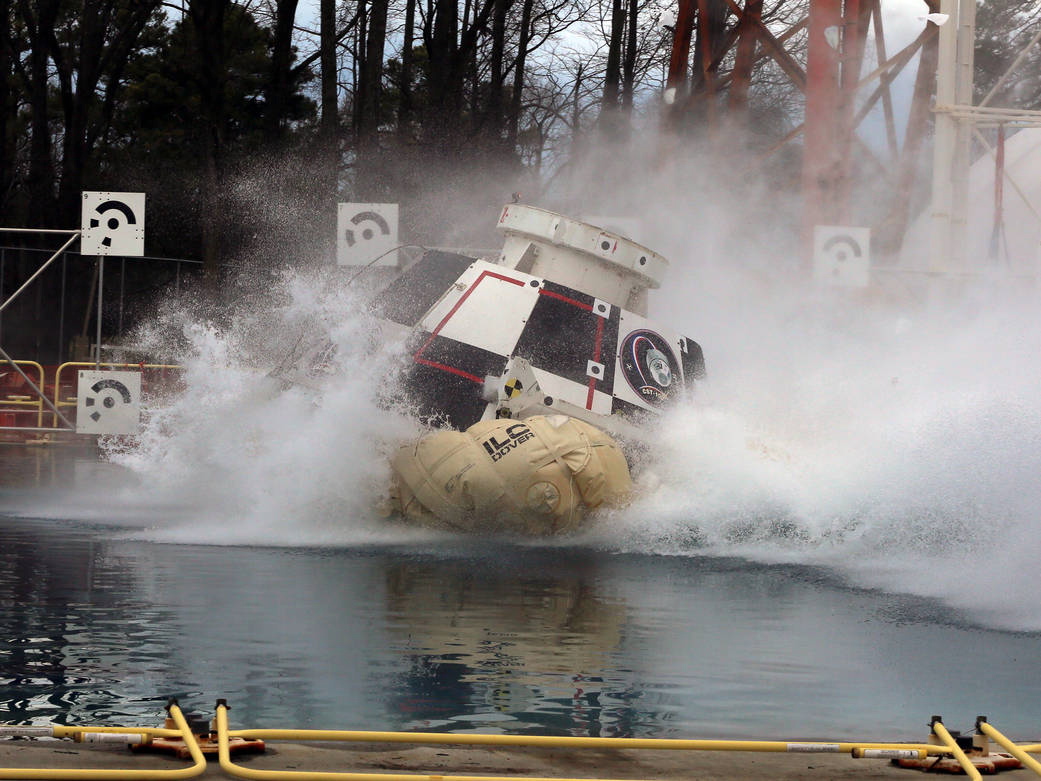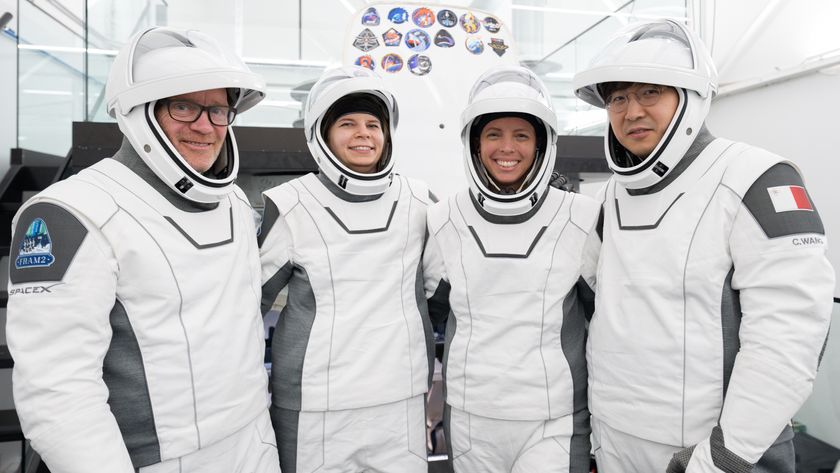Boeing's CST-100 Crew Capsule Takes a Dip

The test, in a tank at the Langley Research Center, was designed to see how the commercial crew capsule would perform should it have to make a splashdown.
The capsule is designed to land on solid ground, using airbags to cushion its landing. [NASA]
More News
Eutelsat says it remains committed to its customer broadband business despite selling a 50 percent stake in Ka-Sat to ViaSat. The company said Wednesday that a joint venture approach allows it to leverage skills in direct-to-consumer sales other companies have, an approach Eutelsat also plans to use in Africa. The satellite operator reported that revenues increased 7.1% for the six months ending Dec. 31 to nearly 775 million euros ($863 million). However, on a "like-for-like" basis, at constant currency and excluding non-recurring revenues, the increase was 1.5%. The increase, outgoing CEO Michel de Rosen said, was "in line" with company expectations, and that it was on track for revenue growth for the full fiscal year of two to three percent. [SpaceNews]
ISRO plans to double its average launch rate to 12 a year in the next five years, a space agency official said Wednesday. YVN Krishna Murthy, ISRO's scientific secretary, said during the "Make in India" conference Wednesday that ISRO is also planning to launch its second lunar mission, Chandrayan 2, in 2017 or 2018, featuring a lander and a rover. ISRO's budget, Murthy said, should be about $1.1 billion this year, up from $0.9 billion last year. [PTI]
Technicians have cleaned mold-contaminated cargo bags destined for the International Space Station. Crews disinfected all the cargo bags carrying equipment to be flown to the station next month after black mold was found on two of them. The source of the contamination isn't clear, but apparently is not the fault of Florida's humid climate: the mold was found in tests performed in Houston, before the bags were shipped to Florida, although the results of the tests weren't available until after the cargo was loaded in the Cygnus spacecraft. That decontamination work has delayed the launch of the Cygnus from March 10 to March 22. [Florida Today]
Georgia legislators are making some modifications to a commercial space bill under consideration. The changes would remove a section that prohibits local officials from enforcing noise regulations against spaceport operators, and gives local residents and businesses a two-year period to file a "nuisance claim" after the first launch from a state spaceport. Other sections of the bill, including liability protections modeled on laws in other states, would remain in place. A hearing about the bill by the Georgia House's judiciary committee is tentatively scheduled for next week. [Camden County (Ga.) Tribune & Georgian]
Get the Space.com Newsletter
Breaking space news, the latest updates on rocket launches, skywatching events and more!
Want to get these briefings even earlier? Here's the signup.
The FAA and the NTSB don't see eye-to-eye on some safety recommendations made after the SpaceShipTwo accident in 2014. The NTSB, in its final report last summer, recommended the FAA's Office of Commercial Space Transportation assigned dedicated safety inspectors to individual operators. The FAA countered that, given its small workforce, its limited number of inspectors should be familiar with a range of launch systems. The NTSB said last month that the FAA's response was "unacceptable" because it describes a system similar to that in place prior to the accident. [Parabolic Arc]
Astronomers have solved the case of the missing asteroids. In a paper published in the journal Nature, researchers said they believe why there is only about one-tenth as many asteroids orbiting close to the sun as models predict. They argued that thermal forces cause asteroids to break apart, either because of thermal stresses as they heat up or because they spin up due to solar radiation. [Los Angeles Times]
NASA is looking to the long term with a Star Trek "replicator" competition for students. The competition, open to K-12 students, challenges them to create a digital 3-D model of a "non-edible, food-related item" that could be 3-D printed by an astronaut — in the year 2050. "We want students to 'boldly go where no one has gone before' with 3-D printing, by making designs that help astronauts eat nutritious meals so they can 'live long and prosper' in locations beyond the International Space Station," the contest website states. Submissions are due May 1. [SPACE.com]
Helpful Astronaut Application Tips
The deadline for submitting applications for the next round of astronaut selections is today. If you're looking for some last-minute advice, the satirical publication The Onion has you covered. It notes that astronaut requirements include "Fifty or more hours logged driving space shuttle around empty NASA parking lot," "Spotless interstellar criminal record," and, perhaps most importantly, "All candidates screened for their ability to procure $18 billion in funding each fiscal year." Good luck!
This story was provided by SpaceNews, dedicated to covering all aspects of the space industry.
Join our Space Forums to keep talking space on the latest missions, night sky and more! And if you have a news tip, correction or comment, let us know at: community@space.com.

Jeff Foust is a Senior Staff Writer at SpaceNews, a space industry news magazine and website, where he writes about space policy, commercial spaceflight and other aerospace industry topics. Jeff has a Ph.D. in planetary sciences from the Massachusetts Institute of Technology and earned a bachelor's degree in geophysics and planetary science from the California Institute of Technology. You can see Jeff's latest projects by following him on Twitter.











